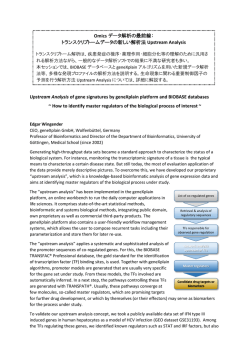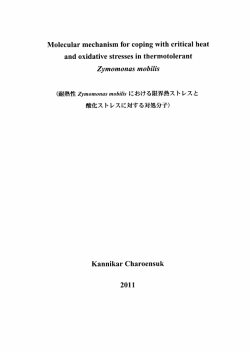
Regulation systems of virulence factors expression and production
氏 Abdelaziz Ahmed Abdallah Mahmoud Elgaml 名 授与した学位 博 士 専攻分野の名称 学 術 学位記授与番号 博甲第 5043 号 学位授与の日付 平成 26 年 9 月 30 日 学位授与の要件 医歯薬学総合研究科 創薬生命科学専攻 (学位規則第5条第1項該当) 学位論文の題目 Regulation systems of virulence factors expression and production in Vibrio vulnificus. (ビブリオ・バルニフィカスにおける病原因子の発現および 産生の調節) 論 文 審 査 委 員 学 教 授 狩野 光伸(主査) 教 授 成松 鎭雄 位 論 文 内 容 准教授 の 要 表 弘志 旨 In the present study I clarified the regulation of virulence factors expression and production in Vibrio vulnificus, including V. vulnificus metalloprotease (VVP), V. vulnificus hemolysin (VVH) and V. vulnificus serine protease (VvsA) according to the quorum sensing (QS), temperature difference during the human infection from 26°C (around estuarine temperature in the summer season) to 37°C (around human intestinal temperature) and bacterial growth. In the first part of this study, I outlined effects of disruption of luxO (encoding the central response regulator protein of the quorum sensing circuit), as well as effects of temperature and growth phase on production of VVP and VVH, and on expression of their genes (vvpE and vvhA). In addition, I examined expression of genes consisting of the QS circuit (luxS, luxT and smcR) and those related to the QS cascade including rpoN and hfq. Moreover, the effects on rpoS and crp which were reported to positively regulate VVP production; and on rpoD were also examined. Disruption of luxO showed increased expression of rpoD, rpoS, luxS, smcR, crp and vvpE. Production of AI-2 and VVP was also distinctly higher in the luxO mutant. The transcription level of vvpE and production of VVP were distinctly higher at 26°C at stationary phase of bacterial growth. It is also noteworthy that the expression of genes encoding positive regulators of vvpE (smcR, rpoS and crp and luxS), and the AI2 production were also higher at 26°C at stationary phase. So, it is concluded that the regulation systems for VVP production are operated strongly at 26°C. Therefore, V. vulnificus can produce a significant amount of VVP in the interstitial tissue of limbs, in which temperature is lower than that in the small intestine and the blood-stream, and VVP produced causes serious hemorrhagic and edematous skin damage. In contrast to VVP, disruption of luxO resulted in less production of VVH, decreased expression of vvhA, luxT and rpoN and no change in hfq expression. The production of VVH reached a maximum level at log phase at 37°C. So, it is concluded that the regulation systems for VVH production are operated effectively at 37°C. Therefore, V. vulnificus produces an enough amount of VVH in the small intestine, which results in acceleration of the bacterial invasion to the blood-stream. In the second part of this study, I clarified the regulatory characteristics of the VvsA production in V. vulnificus strain NCIMB 2137, a metalloprotease-gene negative strain isolated from a diseased eel. The vvsA expression and VvsA activity were compared at 26°C and 37°C at different phases of bacterial growth. Moreover, the vvsA expression and VvsA activity were compared among a wild type strain and its mutants of genes consisting of the QS circuit (including luxS, luxO and smcR). The results of this part showed that VvsA production by V. vulnificus is positively regulated by the LuxSdependent QS system which operated more effectively at 26°C. So, as a human pathogen V. vulnificus may produce a significant amount of VvsA only in the interstitial tissue of limbs, in which temperature is lower than that in the small intestine and the blood-stream, which causes serious collagenolytic, hemorrhagic or edematous skin damage. Also, as an eel pathogen V. vulnificus can produce an enough amount of VvsA via operation of the QS system around the body temperature which results in external and internal hemorrhages affecting the major organs. In the third part of the present study, I clarified the role of the histone-like nucleoid structuring protein (H-NS) in the temperature-dependent regulation of VVP and VVH production as well as the survival of V. vulnificus in stressful environments. H-NS was shown to regulate the expression of vvhA and vvpE genes encoding VVH and VVP, respectively. In the case of VVH, H-NS appeared to affect the vvhA expression by the well-documented transcriptional silencing mechanism. However, in the case of VVP, the gene expression is positively affected by H-NS through enhancing the rpoS mRNA level. Moreover, as a global regulator, H-NS may involve in the regulation of variety of processes required for withstanding diverse environmental stresses. 論 文 審 査 結 果 の 要 旨 以下に記述する点について,審査委員から指摘があり,修正を必要とした。その後,これら 指摘箇所について一対一対応で十分な訂正が行われたリストを伴う改定稿の提出があり,メー ル委員会で最終判定を協議した結果,学位審査委員会は,本研究の学術的意義は十分であり, 本研究科で授与する博士(学術)の学位に値するものと判断し,審査合格と決定した。 General comments: 1. The current draft consists of two published papers, as almost they are, and one unpublished paper draft, each of which has repetitive information. In addition there are general introduction, general summary, and some other parts, which seem prepared for this specific draft. We the committee found this version of the draft not suitable as the doctoral dissertation. The doctoral dissertation should have one main story summarizing the works done in your whole doctoral course, and the story should be written in the structure as follows: 1 Abstract 2 Index of Contents 3-1 Introduction (problem statement + introduce structure of thesis, state contributions) 3-2 Background (The literature review / context of the study) 4 Methods / Materials /with determination of the terms 5 Results / Findings 6 Discussion (Critical assessment of own work = State hypothesis, and demonstrate precision, thoroughness, contribution, comparison with closest rival, and limitation of the study.) 7 Conclusions (Restate contribution ) 8 References 9 Other issues including Acknowledgement From these point of view, your current paper is like three separate papers combined with some general writings. 2. Some schematic figure(s) are needed to summarize the whole story, including the virulence factors studied, somewhere in the paper as well. Specific Comments: 1. Figures copied from other literatures should be clarified with reference(s). 2. There are no clear evidence(s) shown whether knock down of key genes listed below is successful: luxO (p 31), LuxS (p 56), smcR (p61), and hns (p 76). 3. Whether the results of RT-PCR in chapter 2 are quantitative? 4. The results of Western blot, in P37, 38, 78, and 81, lacks information on the amount of the samples loaded, and the baseline for comparison with enzymatic activities and so on. 5. The author often state as “... reached maximum level during early stationary phase”. However, it would hardly be possible to state so only with the results from three stages: early log, late log, and stationary phases. It might be just the highest value was observed in the stationary phase among three. 6. In p55, the author states that “It is clear that transcription of luxS and vvsA are highly correlated to each other.” However, this may be an overgeneralization, if this statement is just based on the fact that the temperature dependencies were the same.
© Copyright 2025

